Fly Fishing the PA Grand Canyon: The Pine Creek DHALO
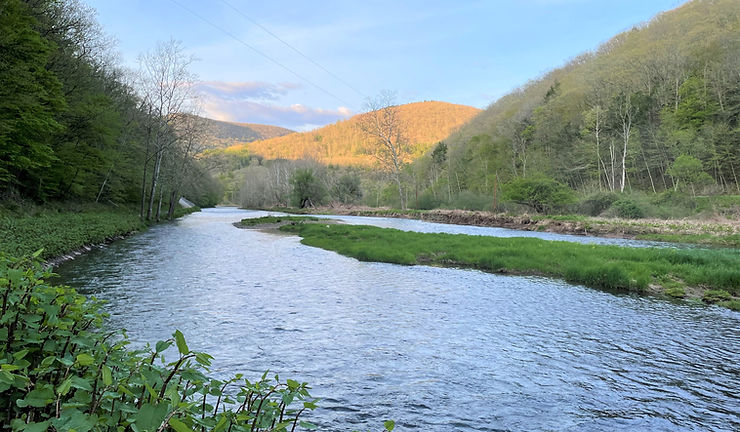
Last year, I decided I was going to regularly fish the Pine Creek DHALO, and I was not disappointed. Here, Pine Creek ranges 100-150 feet wide with deep, strong currents, huge pools, and long, productive runs. It’s big water, but not overwhelming.
However, you don’t just wade out into the middle of the stream and start fishing this section. You have to be a little more methodical about your approach, especially earlier in the spring when water levels are up. Once you step off the bank, the water can get real deep real fast, and like many bigger waters that appear more gentle than they actually are, the current can be deceptively strong in some places. Studded boots and a wading staff are two good investments if you plan to fish Pine Creek very often.
The upper limit of the DHALO begins at the confluence of Marsh Creek near Ansonia, just as the creek makes its turn to head south. From there, Pine Creek flows pretty much straight through the canyon with few big bends, which means that, as you’re fishing, you get some tremendous views of the valley. The lower boundary of the DHALO is the confluence of Bear Run, and the total length of this section is 3.43 miles.
Big Water, Big Trout
The Pine Creek DHALO is one of the Keystone Select Trout waters, and in my opinion is one of the best in the program due to its size. At many other Keystone Select streams I’ve fished, the big trout tend to get caught fairly quickly – usually because the big ones tend to be the most aggressive – but the size of Pine Creek actually protects the trout a bit. There’s just so much great holding water throughout this stretch, and some of it doesn’t even become accessible until water levels drop later in the spring, so it feels as if you’re always over fresh fish.
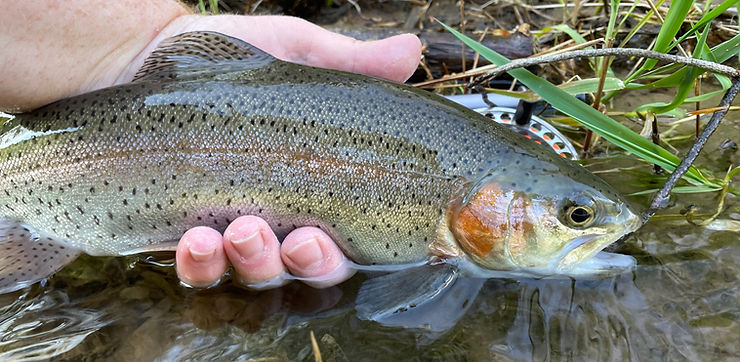
Don’t take that to mean that the Pine Creek DHALO doesn’t get much fishing pressure, though, because it absolutely does. It’s a popular destination for anglers from all parts of the country, and during the peak of the mayfly season, the parking areas along the stream get pretty full. On a positive note, Pine Creek is so big that it can handle a lot of pressure and not feel crowded.
Access to the Pine Creek DHALO is best done two different ways. The first is the Darling Run Access Area off of Route 362/Pine Creek Road. From here, you can hop on the Pine Creek Rail Trail, which closely parallels the east bank of the stream all the way through the gorge and beyond, and walk up or down as far as you care to go.
To access the west bank of the DHALO, take Colton Road from PA Route 6 in Ansonia. After entering the Tioga State Forest, look for Owasse Road on your left. This unmaintained dirt road will take you down a fairly steep grade to the stream and follows the west bank for a little over a mile before it dead ends. There are numerous parking spots along this road, but the road can get rough in places and I don’t recommend this access if you’re worried about beating up your vehicle a little bit.
PA Grand Canyon
Every year, thousands of people visit this region to view the Pine Creek Gorge, a.k.a. PA Grand Canyon, via one of the scenic overlooks within Leonard Harrison State Park or Colton Point State Park. These are amazing views and worth the drive to these places, but viewing the canyon from below, while standing in the middle of the creek, is a whole different experience. From above, you don’t realize how narrow the valley actually is or how steep the hillsides are in some places. Also, standing in the shadows cast by these huge, lovely mountains has a way of making you feel small and insignificant, even humbled, which is exactly how you should feel when viewing any natural wonder.
Evening comes a little earlier in the bottom of the canyon, and air temperatures cool off a little faster. Fishing here this time of day offers something you just don’t get while viewing the canyon from above. It’s the feeling of standing in the midst of ancient giants, and if you close your eyes and feel the cool air moving through the valley, you can almost hear the Earth breathing.
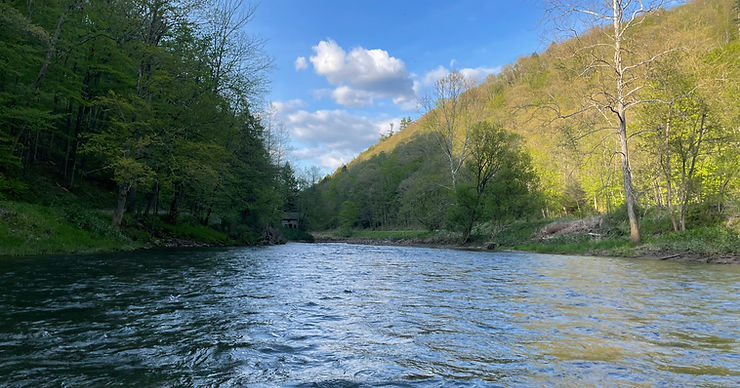
Check out our flies and assortments in our Online Store and gear up for your next fly fishing adventure!
Pine Creek actually flowed in a northeasterly direction until about 40,000 years ago. At that time, the Laurentide Ice Sheet, which covered millions of square miles in this region of the world, began to recede. As it did, this huge continental glacier dammed Pine Creek with rocks and other debris, forming a huge lake near the present-day town of Ansonia. When that lake overflowed, the creek flooded to the south and carved out the 47-mile gorge known today as the Pennsylvania Grand Canyon.
One of the allures of fishing in the canyon is the overall lack of access. Besides the Darling Run Access and Owasse Road, the only other access is near Tiadaghton Campground, via Tiadaghton Hill Road, another unmaintained dirt road that can be a challenge to navigate.
Lack of road access isn’t necessarily a bad thing, though. As mentioned, the Pine Creek Rail Trail parallels the stream throughout the canyon, and you can easily hike or bike into areas that don’t receive much fishing pressure. Also, this is prime water for a float trip with either canoe or raft. Pine Creek Outfitters near Rexford can sometimes provide canoe/boat rentals and shuttle service for those looking for a float fishing adventure.
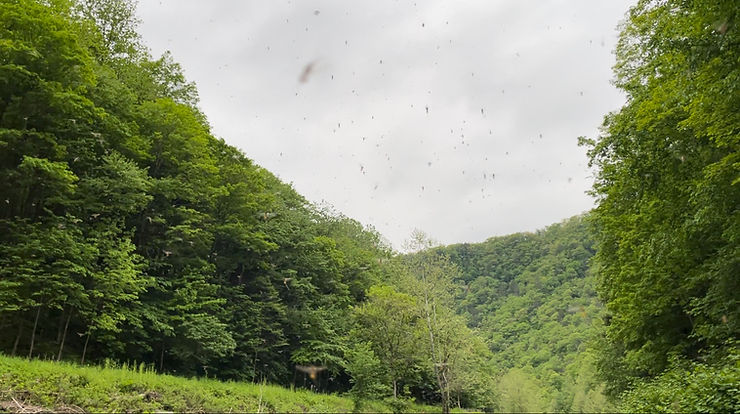
Pine Creek Hatches
I didn’t start fishing Pine Creek until the past 10 years, but from what I’ve read, mayfly hatches have gotten better over the years. Read the section on Pine Creek in Charles Meck’s book Pennsylvania Trout Streams and Their Hatches (published in 1989) and compare it to the section on Pine Creek in Keystone Fly Fishing (published in 2017) and you get the sense that conditions are a lot more favorable now than they were 30 years ago. I hope it’s a trend that keeps going.
Big Pine Creek is home to a plethora of mayfly, stonefly, and caddis species. All of the main ones are found here: Little Black Stoneflies, Blue Wing Olives, Blue Quill, Hendricksons, Quill Gordons, Sulphurs, March Browns, Gray Fox, Brown Drakes, Slate Drakes, Green Drakes, Light Cahills, and an amazing variety of caddis. Some of these hatches are heavier than others, of course, but I never fish Pine Creek without having a little bit of everything in my fly box, just in case.
The timing of hatches can vary from year to year. In recent years, milder winters have led to warmer temperatures earlier than usual. Lower sections of Pine Creek have seen much warmer temperatures early on than what have historically been the case, and some mayfly species show up earlier in those stretches. Generally speaking, though, Pine Creek through the gorge stays cold a little longer into the summer than Pine Creek down near Slate Run, and the hatch dates are more on par with other local streams.
The gorge usually stays fishable well into June. The last two summers, though, each of which brought intense drought conditions and long stretches of hot weather, were hard on Pine Creek trout. When water temperatures get up into the 70s, you’re better off traveling to the lower sections of the stream and focusing on smallmouth bass.
Tips for Fly Fishing Pine Creek
As I’ve mentioned several times already, Pine Creek is big water. The best tip I could give anyone is to try and break that water down into smaller sections, otherwise it can seem overwhelming. Yes, there could be fish anywhere, and in truth, there probably are fish everywhere, but a scattered approach isn’t going to be nearly as effective as focusing on one particular section and working it over in a more methodical manner. In other words, don’t try to hit it all at once.
Another tip that has worked well for me, when nymphing, is to add a small split shot above my fly. Pine Creek is big and deep, but also swift. Even if I’m using an indicator, I’ll often pinch on a small weight to help get the fly down quicker so that I get a longer drift through the most productive water. Also, the little extra weight slows down the drift just a bit and allows the trout more time to identify it as food and eat it.
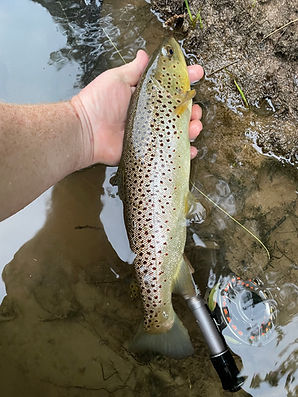
Fourth, practice your casting, particularly the double haul. This will allow you to cover more water during a hatch and reach a few more rising trout without changing positions.
Here's a video from The New Fly Fisher's YouTube page that teaches you how to double haul.
Lastly, wade carefully and don’t take chances. It can be easy, especially during a heavy hatch, to want to wade out a little farther to reach a rising trout, or get a little deeper than you may be comfortable with. That’s usually when you get into trouble – and I know this from personal experience!
Pine Creek is truly an awesome fishery, and the DHALO through the PA Grand Canyon is perhaps one of the most beautiful stretches of water in the whole state. In 1964, Congress included Pine Creek as one of the 27 rivers to be considered for inclusion in the National Wild and Scenic River System. In 1968, the U.S. Department of the Interior designated 12 miles of Pine Creek within the gorge as a National Natural Landmark. In 1992, the 23.25 miles of Pine Creek that flow through the PA Grand Canyon was recognized as a Pennsylvania Scenic River.
I’ve read many articles about Pine Creek in which the writers point out that the Iroquois called Pine Creek Tiadaghton, or “The River of Pines.” But I prefer the other meaning of Tiadaghton, which is “The Lost or Bewildered River.” To me, this more accurately describes the region’s history, from its pristine beauty to near-destruction from pollution and poor forestry practices. For many decades, Pine Creek truly was lost. But up and down the watershed, conservation efforts and better management practices have improved the quality of the water. The stream is surrounded by densely forested mountains again, and the water runs clear and full of trout.
Did You Enjoy Reading This Post About Fly Fishing The Pine Creek DHALO?
Stay up to date with the Dark Skies Fly Fishing monthly newsletter for free and receive the latest in fly fishing news, tricks, tips, and techniques, stream reports, as well as updates on new flies added to the Online Store and exclusive discounts!
Sign Up Now

To me it does not make sense to stock parts of Pine Creek that fisherman cannot easily reach. I say this because most years they really cannot hold over in these places and it is better to put the fish in places where anglers can enjoy them. For the few trout that are present, there is probably enough thermal refuges available to produce some large fish (the fisherman’s dream). I read a biologist’s report about Pine Creek on the Fish Commission’s site that was a little depressing. Its’ conclusion was that much of Pine Creek was too warm to be a good trout fishery and too cool for great smallmouth bass growth. Also stated in the report was that closing fishing around the mouths of tribs was not a real option since the stocked trout that utilize these areas become very food stressed and have limited survival. Their proof was theses stretches required restocking in the fall since not enough fish survive the summer. Also they probably don’t want to enforce sanctuaries at the mouths of the numerous tribs.
All that said, I’ve had some really good fishing in the upper canyon before it was managed as delayed harvest and the fish were big then, particularly after a previous year of favorable wet and cool weather. My wife’s sister lived nearby and I was able to fish it several years in a row. I moved and quite fishing Pine before the delayed harvest was implemented. But in the early 1990’s, I had an evening that was the best brown trout fishing I had had at that time of my fishing life outside of Montana. I moved and quite fishing it before the delayed harvest was implemented. One other thing, the hatches are probably much better now. Water quality essentially eliminated the Hendrickson hatch below Baab Creek around Blackwell. Above that it was supposed to be phenomenal back then, although I did most of my fishing during the grey fox and March brown hatches.
That’s an awesome analysis, William! Thank you for posting this. Your comments really add to the blog post.
It is kind of depressing that it’s too warm for trout but too cold for smallmouth. A few years ago we had a very cool and wet summer and large numbers of trout survived the summer. The fishing the following year was phenomena, to say the least, with all of those stocked browns from the year before having an extra year of growth on them and really keying on every hatch. It was a great year in the gorge!
I am heading up to Wellsboro today to do some fall fly fishing in the canyon for a few days. I live just north of Phila. I have fished the canyon from the mid 70’s and l’ve seen the many changes. The fishing back then was good but has become better because of stream management. I remember when eagles started to return to the canyon. I’ve been a fly fisherman for almost 50 years now and l’m looking forward to being on the canyon again.
Best of luck on your trip! I just got back this morning from two days of fishing Pine Creek near Slate Run. It’s always worth the trip. Hope you have a great and safe time on the water.
Ralph
It would be good if the fish commission would stock more sections along the canyon.I have paddled from Tiadaghton down to Blackwell and after Tiadaghton, the fish seem to be pretty scarce.
I agree. There is a lot of water that doesn’t have many trout. I think the biggest problem with sections through there is lack of access for the stocking trucks. And sometimes it’s a lack of manpower/volunteers willing to float stock those hard-to-access areas.
State should consider removing any obstructions that slow the flow of water.The water behind these obstructions causes the water to heat up like a bath tub. Free flowing water will stay cooler and a few degrees can make a significant difference.
I agree 100%! The only problem is that the primary obstruction influencing the stream is the impoundment in Galeton, Berger Lake. It’s an impossible mission to get anyone in the region to even consider removing that little dam because it’s basically the centerpiece of the town and contributes so much to its identity. Unfortunately, it’s a fairly shallow lake, and as you mentioned, it heats up like a bath tub.
At this point, the only thing that would help would be to dredge out the lake so it’s deeper and then restructure the dam so that it’s bottom release instead of overflow. Again, it would be mighty hard to convince anyone around that a project like that is worth it. Last summer (2023), they did drain the lake and hired a company to dredge it. They didn’t remove much silt, though, and gains were minimal before they ran out of money to actually complete the project the way it needed done.